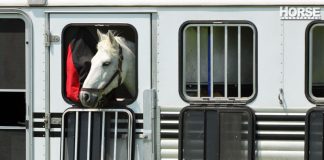
Just when you couldn’t wait for winter and all it entails to end, now you’re battling a different foe than ice and snow: mud. Whether ankle deep or axle-deep, mud is a pain when trying to dump wheelbarrows, turn horses out or just complete basic farm chores.
Below are some ways to combat mud on your farm:
- Install rain gutters and downspouts on barns and outbuildings. These will help direct water away from paddocks and foundations. One inch of rain on a 20-foot by 50-foot barn produces 620 gallons of water. In an area with an average rainfall of 40 inches, that’s an additional 25,000 gallons of water—an amount well worth diverting from paddocks and driveways!
- Put footing on top of landscape fabric in heavily traveled aisles, walkways and driveways. The fabric ensures the dirt stays in place while water can still flow through it, so it doesn’t pool.
- Fence horses out of streams, ponds and low-lying areas on your farm. Hooves will trample embankments and shorelines, creating an ever-expanding mess of mud.
- Place bridges over low-lying areas in walkways between paddocks.
- Restrict horses from the wettest parts of your farm during wet weather using temporary fencing or utilizing a sacrifice lot.
- During the warmer season, don’t allow horses to graze growing grass too short. Grass without a good root system in place loses its ability to prevent runoff and is easily trampled into mud.
- Remove manure around heavily trafficked areas like waterers, hay feeders and gates at least once a week.
- Consider installing French drains, which intercept water flowing through paddocks and pastures using trenches filled with gravel, then flows toward a specific outlet.
- Place sand, gravel or wood chips around gates, waterers and feeders and even in run-in sheds. These materials are always more effective when used on top of landscape fabric to prevent them from sinking into the soil. A good rule of thumb is to put down twice as much footing as you have mud, generally at least 6 inches deep. Large wood chips will decompose over time, so adding a new layer each year is recommended. Gravel will last longer, but be aware that gravel larger than 5/8-inch can be uncomfortable for horses to stand on. Sand is also an option, but care must be taken that horses are not fed on it as it can accumulate in the gut and cause sand colic.
- Investigate soil stabilizing grid systems that allow grass to grow through the grid, protecting roots and preventing mud.
- Move hay feeders periodically so horses are not chronically forced to stand in mud to eat. This will allow the muddy areas to dry out while horses spend their time elsewhere.
- Plant trees and shrubs. Thought not immediately beneficial, plants use a lot of water and can reduce the standing water on your farm. Planted around paddocks (make sure they are equine-safe), shrubs can keep them drier and reduce runoff. Check to ensure that all plants you use on your property are horse-safe.
Liked this article? Here’s more on managing mud:
Question of the Week: Corral Mud Management
Mud-Related Health Problems
Pasture Maintenance
Sarah Coleman has a soft spot for chestnuts with chrome, including her off-the-track Thoroughbred that she competes in the hunters. Based in Lexington, Ky., she is the Director of Education and Development for New Vocations Racehorse Adoption Program.






Most of these suggestions, are not even practical on heavy clay soil in our barn yard. I can not let the horses out to pasture in the spring time, until things start drying out, I do put old straw and sawdust or wood chips in the worst areas, but I wish I had better means of caring for the horses when “mud season” is here.
Great tips.
Adding organic material to the mud like hog fuel is cheap, but very temporary. Eventually it breaks down and makes more mud. And if you try to put landscape fabric underneath to prevent it from mixing in with the mud, the joke’s on you because once there is mud on top of the fabric it is insanely hard to get the stuff out. And you will want it out because loose ends of fabric that come up out of the ground can pull off shoes and catch on tines of your muck fork.. Not that I have made these mistakes before 😉
This is what we use on our boarding farm:
Lighthoof Equine Mud Management Panels. Video and info at http://www.lighthoof.com
We install it just in the front of our paddocks where the worst mud is. The horses actually prefer to stand on it which reduces the wear and tear on the rest of the paddock.
For most arenas, topsoil, footing, and base layers all become compacted over time. This is because the more often the area is used, experiences difficult weather, and simply ages over time, the more different layers of your arena bleed into one another. This makes all layers less effective.